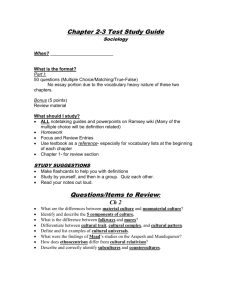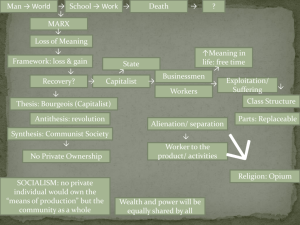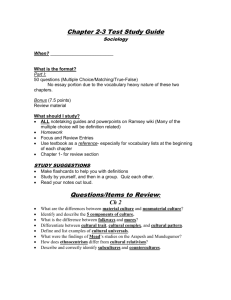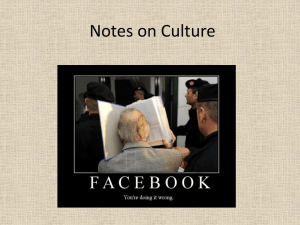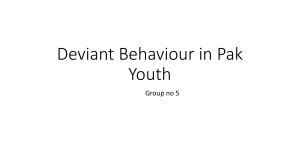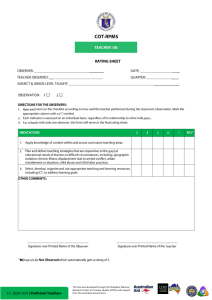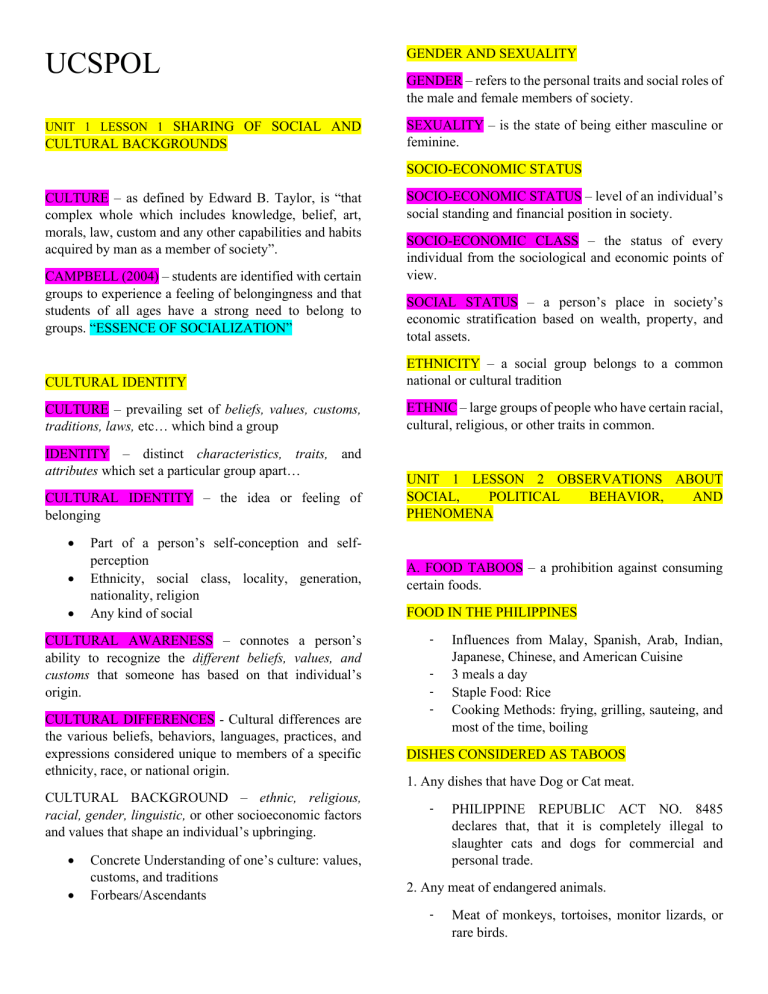
UCSPOL GENDER AND SEXUALITY UNIT 1 LESSON 1 SHARING OF SOCIAL AND SEXUALITY – is the state of being either masculine or feminine. CULTURAL BACKGROUNDS GENDER – refers to the personal traits and social roles of the male and female members of society. SOCIO-ECONOMIC STATUS CULTURE – as defined by Edward B. Taylor, is “that complex whole which includes knowledge, belief, art, morals, law, custom and any other capabilities and habits acquired by man as a member of society”. CAMPBELL (2004) – students are identified with certain groups to experience a feeling of belongingness and that students of all ages have a strong need to belong to groups. “ESSENCE OF SOCIALIZATION” SOCIO-ECONOMIC STATUS – level of an individual’s social standing and financial position in society. SOCIO-ECONOMIC CLASS – the status of every individual from the sociological and economic points of view. SOCIAL STATUS – a person’s place in society’s economic stratification based on wealth, property, and total assets. CULTURAL IDENTITY ETHNICITY – a social group belongs to a common national or cultural tradition CULTURE – prevailing set of beliefs, values, customs, traditions, laws, etc… which bind a group ETHNIC – large groups of people who have certain racial, cultural, religious, or other traits in common. IDENTITY – distinct characteristics, traits, and attributes which set a particular group apart… CULTURAL IDENTITY – the idea or feeling of belonging • • • Part of a person’s self-conception and selfperception Ethnicity, social class, locality, generation, nationality, religion Any kind of social CULTURAL AWARENESS – connotes a person’s ability to recognize the different beliefs, values, and customs that someone has based on that individual’s origin. CULTURAL DIFFERENCES - Cultural differences are the various beliefs, behaviors, languages, practices, and expressions considered unique to members of a specific ethnicity, race, or national origin. CULTURAL BACKGROUND – ethnic, religious, racial, gender, linguistic, or other socioeconomic factors and values that shape an individual’s upbringing. • • Concrete Understanding of one’s culture: values, customs, and traditions Forbears/Ascendants UNIT 1 LESSON 2 OBSERVATIONS ABOUT SOCIAL, POLITICAL BEHAVIOR, AND PHENOMENA A. FOOD TABOOS – a prohibition against consuming certain foods. FOOD IN THE PHILIPPINES - Influences from Malay, Spanish, Arab, Indian, Japanese, Chinese, and American Cuisine 3 meals a day Staple Food: Rice Cooking Methods: frying, grilling, sauteing, and most of the time, boiling DISHES CONSIDERED AS TABOOS 1. Any dishes that have Dog or Cat meat. - PHILIPPINE REPUBLIC ACT NO. 8485 declares that, that it is completely illegal to slaughter cats and dogs for commercial and personal trade. 2. Any meat of endangered animals. - Meat of monkeys, tortoises, monitor lizards, or rare birds. 3. Any food that violates human dignity because they are not any more acceptable for human consumption by public opinion. - - “double-dead meat’ or “botcha” - pork, beef, and chicken meat coming from previously already dead animals “pagpag” FOOD PROHIBITED TO OTHERS BECAUSE OF RELIGION - Muslims, some protestants, 7th-day Adventist do not eat pork Dinuguan B. THE STANDBY (ISTAMBAY) PHENOMENON English idiom (On Stand By) - A person who does not have work and who usually hangs out on street corners. (1) an act of spending one’s time unprofitably; idler (2) a person who spends his time unprofitably. Synonymous to: paglalakwtsa’ (gallivanting), ‘taongtamad’ (lazy person), and ‘di ginagamit’ (not being used) C. POLITICAL DYNASTY - families whose members are engaged in politics have been in the Philippine political structure since time passed. - Many believe that Political dynasties are one the root of poverty and corruption. SEC. 26 ARTICLE II DECLARATION OF PRINCIPLES AND STATE POLICIES, 1987 PHILIPPINE CONSTITUTION D. PHILIPPINE ELECTIONS - The President, as per the 1987 Philippine Constitution, is limited to a single term and is barred from running for re-election. The Vicepresident, on the other hand, may run for re-election or may opt for a higher position. THE PRESIDENT, VICE-PRESIDENT, AND THE SENATORS - elected on national or popular elections and serve for a six-year term. The members of the House of Representatives, and the local government officials, namely: governors, vicegovernors, members of the provincial board, mayors, vice-mayors, the city/municipal councilors are elected for a term of three years and are eligible for re-elections. - The Senate or Upper House has 24 members which are elected on a nationwide at-large basis. The lower half of the Senator’s term is renewed every three years. The House of Representatives or Lower House has 250 seats of which 80% are contested in congressional districts and 20% are allotted to party-lists. - In the Philippines, the common dictum in the vernacular is “Kaya siya nanalo kasi nandaya siya; Kaya siya natalo kasi dinaya siya.” UNIT 2 LESSON 1 SOCIETY SOCIETY – is a group of people interacting and having common culture; sharing common geographical or territorial domains. THEORIES ON HUMAN SOCIETY REPUBLIC; PLATO (427-347 BC) – society ruled by philosopher-king POLITICS; ARISTOTLE (384-322 BC) – man is selfsufficient and that those who are unable to live in society and have no needs in life must be either beasts or gods. CITY OF GOD ST. AUGUSTINE (354-430) – society’s ultimate pilgrimage, community that worshipped God. UTOPIA, (1516), SIR THOMAS MORE (1468-1535) – “ideal”, imaginary island nation whose political system he described. TYPES OF SOCIETIES A. PRE-INDUSTRIAL SOCIETIES 1. HUNTING AND GATHERING SOCIETY – collection of wild animals and plants, no permanent villages, larger groups and formed complex hierarchical social structures such as chiefdoms - limited sizes, consists of 60-100 people - social statuses are relatively equal 2. PASTORAL SOCIETY – depends on domesticated herd of animals to meet their need in food. 3. HORTICULTURAL SOCIETY – raise both fruits and vergetables in garden plots. - kaingin sytem - wild vegetation is cleared, cut, and burned then the ashes are used as fertilizer - horticulturalist make use of human labor and simple tools. 4. AGRARIAN SOCIETY – agricultural revolution (8,500 years ago) - technological changes occurred leading to extensive cultivation of crops and raising of farm animals. - increases food supplies, and larger group 5. FEUDAL SOCIETY – several groups become wealthy and able to acquire lands and declared these as their own domain. - ownership of land - Vassals then under feudalism were bound to cultivating their feudal’s master land. - multi-generational ANIMAL LEVEL - is characterized by desires for sex and reproduction. At this stage man is no different from animals in their need for food and sex. At this stage, the socialization of man is incomplete. B. INDUSTRIAL SOCIETIES – between 15th and 16th century, “Capitalism”, characterized by free competition, free market, and the right to acquire private property, emerged. 1. FOLKWAYS – are customary ways of doing things which are fairly weak form of norms. They are habits, customs, and repetitive patterns of behavior. C. POST-INDUSTRIAL SOCIETIES - more advanced society called post-industrial society, dominated by information services and high technology, surfaced. Government, research, education, health, sales, law, and banking. D. MODERN SOCIETIES – money as main medium of exchange, trade and commerce. Banks also serves as a source of unearned money. UNIT 4 LESSON SOCIALIZATION 1 ENCULTURATION AND ENCULTURATION - is the process by which individuals acquire the knowledge, skills, attitudes, and values that enable them to become functioning members of their societies. SOCIALIZATION - on the other hand, is the process whereby the individuals behavior is modified to conform to the expectation of the group. THREE LEVELS OF HUMAN DEVELOPMENT VEGETATIVE LEVEL - refers to embryo and early infancy. This is characterized by preoccupation with food. The infant grabs things and brings them directly to the mouth. The main thought of the infant is survival. HUMAN LEVEL - is considered the attainment of human of a personality. This implies the assimilation of behavior, attitudes, and values the society considers necessary and important to the well-being of the group. SOCIAL NORMS AND SOCIAL VALUES SOCIAL NORMS - Are standards of behavior which tell whether an action is right or wrong; appropriate or not. They represent standardized generalizations concerning expected modes of behavior. Among the norms observed by society include folkways, mores and laws. Examples: Mano Po – Blessing of the hand/means “right”[opposite of left] and po is a word to show respect. Po and Opo – respect you use among elders in the Filipino Culture, respect for older people. Bayanihan – refers to a spirit of communal unity or effort to achieve a particular objective. Harana – old Filipino courtship tradition, influenced by Spaniards Pamamanhikan – Panhik “ascend stair”, is the asking for the girl’s parents’ permission to wed the affianced pair. 2. MORES – Are special folkways with moral and ethical values which are strongly held and emphasized, includes the customs, values, and behaviors that are accepted by a particular group. 3. LAWS – are formalized norms enacted by people vested with authority. These laws reinforce the mores. 4. SANCTIONS – are penalties or other means of enforcement used to provide incentives for obedience with the law, or with rules and regulations. FORMS OF SANCTIONS A. INFORMAL SANCTIONS – come in unfavorable or favorable public opinion, giving or withdrawing of support, or gossip. B. FORMAL SANCTIONS – certifications for achievements APPLICATION OF SANCTIONS A. PHYSICAL SANCTIONS – bring physical pain or pleasure. Ex: Having it brings pleasure, losing it brings pain. B. PSYCHOLOGICAL SANCTIONS – address feelings and emotions of person. They can make one feel good or bad. POSITIVES – compliments, NEGATIVES – insults and rejection SOCIAL VALUES - are cultural standards that indicate the general good deemed desirable for organized social life STATUS AND ROLE STATUS – refer’s to one’s position or place in a social group. Assigned to an individual from birth; or achieved. UNIT 4 LESSON 2 CONFORMITY AND DEVIANCE TYPES OF SOCIAL CONTROL DIRECT CONTROL – is exercised by the primary groups like family, peer group, who praise or condemn the behavior of an individual INDIRECT CONTROL – is exercised by the secondary groups like traditions, customs, institutions, etc. POSITIVE AND NEGATIVE MEANS - The positive means of social control is through praise, prizes, fame, respect and promotion. The negative means include criticism, gossip, punishment and ostracism. FORMAL CONTROL – is designed and regulated by some authority like the government which makes laws to control order. INFORMAL CONTROL – is the unwritten rules and regulation characterized by informal authority like criticism, sociability, and public opinion. DEVIANCE – is defined as the recognized violation of cultural norms. ROLE – refers to functional and dynamic aspect of the status. EXPLANATIONS FOR DEVIANT BEHAVIORS FORMS OF ROLES A ROLE AS EXPECTATION – refers to the rights, duties, and obligations an individual has while occupying a status. B. ROLE AS PERFORMANCE – refers to how the individual actually behaves while occupying status. C. ROLE CONFLICT - Conflict arises when an individual encounters conflicting demands from his two or more statuses. This happens when in his performance of one role; such would run counter to another role. D. ROLE SET - refers to the individual‘s repertoire (list) of performances towards variety of others while he/she occupies a given status. SOCIALIZATION FOR SEX ROLES - Societies categorize their members into males and females and each is viewed as a distinct sex or gender. Gender differences are a function of cultural patterns which prescribe the different expectations and norms of behavior for boys and girls. PATHOLOGY • • Social Pathology considers deviant behavior as the result of a societal disease which must be isolated, contained and treated. Biological pathology maintains that deviance results from actual physical illness, malfunctions or deformities. SOCIAL DISORGANIZATION – Cultural conflict suggests that deviant and criminal behavior results when two normative systems come into contact LABELING – The labeling theory of deviant behavior suggests that what defines deviance is the action of others or by the actors themselves. VALUE CONFLICT – This theory holds that acts are considered criminal or deviant because they are at variance with a group’s values MOST COMMON DEVIANCE • Homosexual • Drug addiction • Alcoholism • Murder • Prostitution • Lesbianism • Mental Illness MODES OF ADAPTATION • Conformist – is a person who accepts both the societal goals and the approved means to reach them. • Innovator – is a person who seeks to achieve goals by means that are not approved by the society. • Ritualist – is a person who follows the norms to the letter but reject or abandon the hope of achieving societal goals. • Retreatist – is a person who rejects both the societal goals and institutionalized means to achieve them. • Rebel – is a person who rejects both the societal goals and the means to achieve them; instead he substitutes them with new goals and new means to achieve them. PREAMBLE We, the sovereign Filipino people, imploring the aid of Almighty God, in order to build a just and humane society, and establish a Government that shall embody our ideals and aspirations, promote the common good, conserve and develop our patrimony, and secure to ourselves and our posterity, the blessings of independence and democracy under the rule of law and a regime of truth, justice, freedom, love, equality, and peace, do ordain and promulgate this Constitution.
